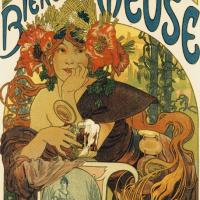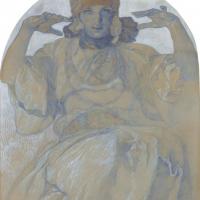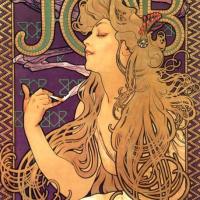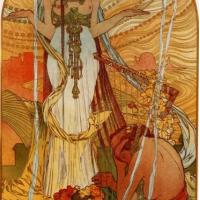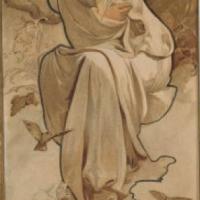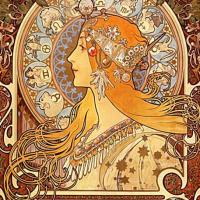Alphonse Mucha
Bieres De La Muse
$480.00
Cycles Perfecta
$480.00
Jaroslava Mucha
$480.00
Job
$480.00
Job Cigarettes 1
$480.00
Poetry
$480.00
Salammbo
$480.00
The Seasons
$480.00
Zodiaque
$480.00
Alphonse Mucha
Alphonse Mucha (1860-1939)
Alfons Maria Mucha (24 July 1860 – 14 July 1939), known in English and French as Alphonse Mucha, was a Czech painter, illustrator and graphic artist, living in Paris during the Art Nouveau period, best known for his distinctly stylized and decorative theatrical posters of Sarah Bernhardt. He produced illustrations, advertisements, decorative panels and designs which became among the best-known images of the period.
In the second part of his career, at the age of 43, he returned to his homeland and devoted himself to painting a series of twenty monumental canvases known as The Slav Epic, depicting the history of all the Slavic peoples of the world, which he painted between 1912 and 1926. In 1928, on the 10th anniversary of the independence of Czechoslovakia, he presented the series to the Czech nation. He considered it his most important work. It is now on display in the National Gallery in Prague.
The success of the Bernhardt posters brought Mucha commissions for advertising posters. He designed posters for JOB cigarette papers, Ruinart Champagne, Lefèvre-Utile biscuits, Nestlé baby food, Idéal Chocolate, the Beers of the Meuse, Moët-Chandon champagne, Trappestine brandy, and Waverly and Perfect bicycles. With Champenois, he also created a new kind of product, a decorative panel, a poster without text, purely for decoration. They were published in large print runs for a modest price. The first series was The Seasons, published in 1896, depicting four different women in extremely decorative floral settings representing the seasons of the year. In 1897 He produced an individual decorative panel of a young woman in a floral setting, called Reverie, for Champenois. He also designed a calendar with a woman's head head surrounded by the signs of the zodiac, The rights were resold to Léon Deschamps, the editor of the arts review La Plume, who brought it out with great success in 1897. The Seasons series was followed by The Flowers The Arts (1898), The Times of Day (1899), Precious Stones (1900), and The Moon and the Stars (1902). Between 1896 and 1904 Mucha created over one hundred poster designs for Champenois. These were sold in various formats, ranging from expensive versions printed on Japanese paper or vellum, to less expensive versions which combined multiple images, to calendars and postcards.
His posters focused almost entirely on beautiful women in lavish settings with their hair usually curling in arabesque forms and filling the frame. His poster for the railway line between Paris and Monaco-Monte-Carlo (1897) did not show a train or any identifiable scene of Monaco or Monte-Carlo; it showed a beautiful young woman in a kind of reverie, surrounded by swirling floral images, which suggested the turning wheels of a train.
The fame of his posters led to success in the art world; he was invited by Deschamps to show his work in the Salon des Centexhibition in 1896, and then, in 1897, to have a major retrospective in the same gallery showing 448 works. The magazine La Plume made a special edition devoted to his work, and his exhibition traveled to Vienna, Prague, Munich, Brussels, London, and New York, giving him an international reputation.
In the political turmoil of the 1930s, Mucha's work received little attention in Czechoslovakia. However, in 1936 a major retrospective was held in Paris at the Jeu de Paume museum, with 139 works, including three canvases from the Slav Epic.
Hitler and Nazi Germany began to threaten Czechoslovakia in the 1930s. Mucha, began work on a new series, a triptych depicting the Age of Reason, the Age of Wisdom and the Age of Love, which he worked on from 1936 to 1938, but never completed. On 15 March 1939, the German army paraded through Prague, and Hitler, at Prague castle, declared the German Protectorate of Bohemia and Moravia. Mucha's role as a Slav nationalist and Freemason made him a prime target. He was arrested, interrogated for several days, and released. By then his health was broken. He contracted and died of pneumonia on 14 July 1939, a few weeks before the outbreak of the Second World War. Though public gatherings were banned, a huge crowd attended his interment in the Slavín Monument of Vyšehrad cemetery, reserved for notable figures in Czech culture.
Mucha was and remains best known for his Art Nouveau work, which frustrated him. According to his son and biographer, Jiří Mucha, he did not think much of Art Nouveau. "What is it, Art Nouveau?" he asked. "...Art can never be new." He took the greatest pride in his work as a history painter.
Although it enjoys great popularity today, at the time of his death Mucha's style was considered outdated. His son, author Jiří Mucha, devoted much of his life to writing about him and bringing attention to his artwork. In his own country, the new authorities were not interested in Mucha. The Slav Epic was rolled and stored for twenty-five years before being shown in Moravský Krumlov. The National Gallery in Prague now displays the Slav Epic, and has the major collection of his work.
Mucha is also credited with restoring the movement of Czech Freemasonry.
One of the largest collections of Mucha's works is in the possession of former world no. 1 professional tennis player Ivan Lendl, who started collecting his works upon meeting Jiří Mucha in 1982. His collection was exhibited publicly for the first time in 2013 in Prague.


